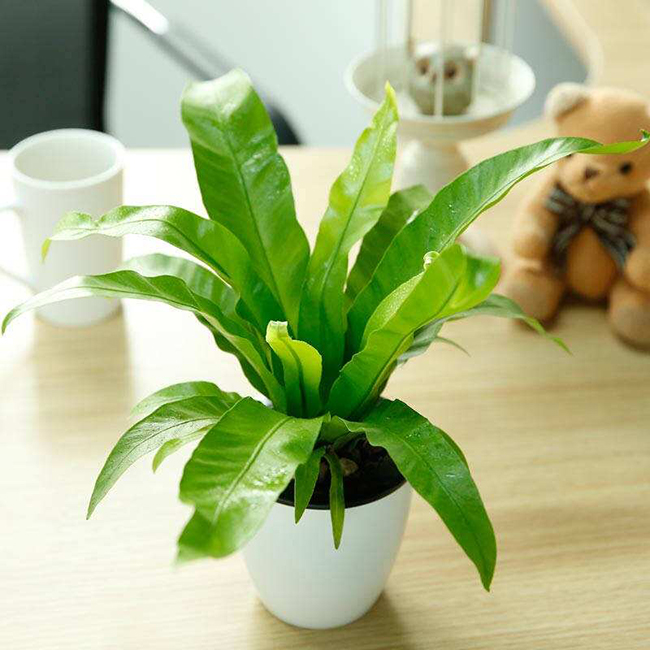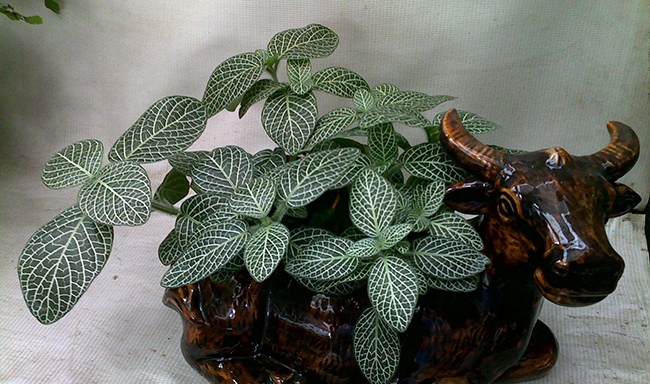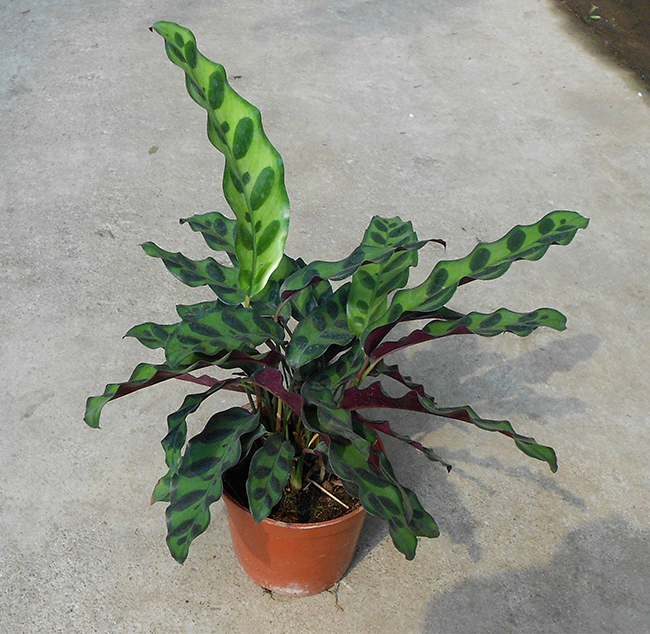Breeding methods and matters needing attention of bird nest fern
Growth habits of bird's nest fern
Bird's nest ferns are often attached to tree trunks or rocks in rainforests or seasonal rain forests. they like high temperature and humidity and are not resistant to strong light.

Culture method of bird nest fern
1. Temperature:
The suitable temperature for its growth was 16 ℃ to 27 ℃, 22 ℃ to 27 ℃ from March to October and 16 ℃ to 22 ℃ from October to March of the following year. When the temperature exceeds 30 ℃ in summer, measures such as building a shed to shade and spraying water on the fern of the bird's nest should be taken to reduce the temperature and humidification, so that it can continue to maintain its exuberant growth. Whether it is family pot cultivation or productive cultivation, it is best to keep the greenhouse temperature above 15 ℃ in winter so that it can continue to grow. when the conditions are not available, the greenhouse temperature should be kept at least not lower than 5 ℃. If the temperature is too low, the leaf margin will turn brown, and even the plant may die due to cold injury.
2. Lighting:
The native environment of bird's nest fern is moist jungle, and it can grow normally with a small amount of scattered light, so potted plants can be preserved in bright indoor light all the year round. Such as spring and autumn short-term placed in the shade of outdoor trees or in the greenhouse, it is more conducive to its growth, and can increase the luster of the leaves. Potted bird's nest fern must not be exposed to the hot sun, otherwise the plant will appear abnormal phenomena such as worse leaf color, leaf surface burns, leaf edge scorch and so on, which will reduce its ornamental value. It should be shelved under the shade of more than 70% shade in summer, which is beneficial to its growth. In winter, light should be given properly in the shed, and artificial supplementary light should be given in too dark places.
3. Moisture:
Potted bird's nest fern requires not only moist soil, but also high relative air humidity. Watering should be sufficient in the growing season, especially in summer, in addition to often watering the cultivation substrate, the leaf surface must be washed 2 to 3 times a day, and the surrounding ground must be sprinkled to humidify the local environment to maintain a higher air humidity, which can not only increase the gloss of the leaf surface, but also very beneficial to the germination of spore leafs. if the basin soil is short of water or the air is relatively dry, it is easy to cause the leaf edge to dry and curl. When the temperature is low in winter, it is better to keep the basin soil moist, spraying more water and watering less, so as to avoid rotting roots caused by too much water in the basin soil at low temperature. Because its leaves are leathery and can prevent the evaporation of water, it can also withstand for a short time.
Because of this, it is more suitable for indoor cultivation and display.
4. Soil:
The pot substrate can be mainly composed of rotten leaf soil or peat soil, vermiculite, mixed with a small amount of river sand, or mixed with fern root, broken bark, moss or broken brick particles and a small amount of humic soil. Where there are conditions, it is best to use porous flowerpots or porous plastic baskets as containers, with broken bricks of 1x3 at the bottom, which can be filled with fern roots, bark blocks, moss, rotten leaf soil, and so on, and then plant the roots of bird's nest ferns into them, so that they will grow more vigorously. The potted bird's nest fern can be changed every 2 years, take it out of the flowerpot, shake off the persistent soil, cut off part of the residual roots and withered yellow leaves, peel off the sub-plant and plant it separately, and the old plant can be planted with a slightly larger pot after changing the cultivation medium. In addition, a little crushed lime can be added to the basin every spring, which is beneficial to the growth and development of its parasperm.
5. Fertilizer:
The special shape and structure of bird's nest fern is beneficial to its absorption of water and nutrients. Its rhizome is short and densely scaly, and produces a large mass of spongy fibrous roots, which can absorb more water. Leaves radiate at the top of the rhizome, in the shape of a bird's nest or hollow funnel, in the primary environment can collect deciduous leaves and birds and Rain Water in their nests, these substances are transformed into humus, which can be used as an important part of their own source of nutrients. Potted bird's nest fern, in its vigorous growing season, should be irrigated with a balanced thin fertilizer of nitrogen, phosphorus and potassium every semimonthly, which can promote it to grow a large number of new leaves. If the plant is short of fertilizer, the leaf edge will turn brown. If the summer temperature is higher than 32 ℃ and the greenhouse temperature is lower than 15 ℃ in winter, all forms of topdressing should be stopped.
Notes on bird's nest fern
1. The pot soil should be peat soil or rotten leaf soil to keep the temperature at 22-27 ℃.
Second, the temperature is high in summer, the new leaves of bird nest fern need to spray more water to maintain proper air humidity and promote spore germination.
Third, keep proper sunlight and avoid direct sunlight.
Fourth, keep the basin soil moist when the temperature is low in winter. Disease and insect control of bird's nest fern
1. Disease anthrax:
In the environment of high temperature, high humidity and poor ventilation, the leaves are easy to be infected with anthracnose, the disease spot is brown, and the wheel pattern is obvious in the later stage.
Prevention and treatment: at the initial stage of the disease, 75% chlorothalonil wettable powder, 1000 times methyl topiramate wettable powder, or 10% Shigao water dispersible granule 2500 times can be sprayed uniformly, once every 10 days, 3 to 4 times in a row. In addition, attention should be paid to prevent sunburn, cold injury and so on.
2. Pest nematodes:
Nematodes harm bird's nest ferns and can cause brown reticular spots on the leaves.
Control method: Kelindan or carbofuran granules can be used to spread on the surface of basin soil, and the insecticidal effect is better.
How to maintain the breeding methods and matters needing attention of bird nest fern
The emerald green leaves of the bird's nest fern spread naturally, like a passionate young man, waving to you. In addition to beauty, it also has medicinal value. So what exactly is the breeding method and points for attention of this bird nest fern all over the body? I believe everyone would like to know, then the following content should not be missed.
Culture methods and matters needing attention of bird nest fern
The bird's nest fern, also known as the mountain flower, is a plant of the fern family Dryopteris, native to eastern Australia, southeastern Asia and Indonesia. The plant is about 0.8-1 m high, with an erect stem, thick and short, the whole scale is broad lanceolate, the main veins are raised on both sides, and the rest of the leaves are scattered naturally. Like other ferns, it produces spores, has no flowering stage, and likes to grow in a hot and humid environment, but it can't help the strong light.
The suitable temperature for growth is between 16 ℃ and 27 ℃, and it is required to grow in wet basin soil and has higher relative air humidity. Due to the high temperature in summer, frequent watering is needed to ensure that the plant has enough water so that the leaves do not dry up and curl. When selecting pot substrate, we can mainly use rotten leaf soil, vermiculite or peat soil, and add a small amount of river sand as culture soil. In the early stage of its growth, it needs to be fertilized every 20 days, and when it matures, it cannot help but apply additional fertilizer.
Edible / medicinal value of bird's nest fern
What many people don't know is that bird's nest ferns have many uses in addition to ornamental value.
It is a little expert at purifying the air. Bird's nest fern is also a necessary green plant in the new house, because it can purify the air and remove the strong smell of formaldehyde, it is also one of the recommended gifts for new homes.
It is a good helper for treating injuries and recuperating diseases. Because it is rich in potassium, iron, calcium, vitamin A, dietary fiber and other substances, it can strengthen muscles and bones, promote blood circulation and remove blood stasis. In addition, it can also be used in the treatment of fractures, headaches, and other diseases.
It is a good dish that tastes bitter and delicious. The tender part of the bird's nest fern can be eaten as long as it is washed and slightly blanched in boiling water, or it can be eaten as a side dish with other ingredients.
After reading the introduction of the bird's nest fern covered with treasures, do you want to raise a bird's nest fern? Although the breeding of bird's nest ferns is not difficult, it should not be taken lightly. You know, it takes time and patience to cultivate a plant well. I hope all plant lovers can get some inspiration from it.
Breeding methods and matters needing attention of bird nest fern
Bird's nest fern is a kind of plant with erect rhizome, thick short, woody, about 2 cm thick and dark brown, which is 80 cm to 100 cm high. It is native to southeast Asia, eastern Australia, Indonesia, India and eastern Africa. It is widely distributed in tropical China. Bird's nest ferns are often attached to the tree trunks or rocks in the rainforest or seasonal rain forest, preferring high temperature and humidity and not resistant to strong light. Today, let's take a look at the breeding methods of bird's nest ferns and the precautions for yellowing the leaves of bird's nest ferns. Bird's nest fern is a species of fern belonging to the family Pteridaceae, which is a perennial herbaceous foliage plant. It also has another name. Bird's nest fern likes to grow on tree trunks and rocks in the rainforest or seasonal rain forest. It prefers high temperature, wet and soft environment, but it is not resistant to strong light. Bird's nest fern-like plants about 80 cm tall, rhizomes erect, stout, woody, ca. 2 cm thick, dark brown, apex densely scaly. Scales broadly lanceolate, ca. 1 cm, apex acuminate, entire, thin membranous, dark brown, slightly glossy. It has the function of strengthening muscles and bones, promoting blood circulation and removing blood stasis, and is also suitable for injury, fracture, blood stasis, headache, hemolysis, impotence, gonorrhea and other diseases. Breeding method of bird's nest fern [sowing]: the best soil for potted bird's nest fern is peat soil or rotten leaf soil, and pot planting is carried out in spring. Mix the fine sand and humus soil well, disinfect it at high temperature, put it into the sowing basin and flatten it, spread the mature spores evenly on the basin soil, then soak the basin soil in shallow water, make the basin soil fully moist, cover the glass to moisturize, and place it in a warm, cool place. Bird nest ferns can germinate in 7-10 days, and green primary leaves will grow after about 1 month, and a few true leaves will grow 3 months later. Before it can be cultivated in the pot. [ramets]: bird's nest ferns can be ramified in late April every year. Generally, when ramets are selected, the sturdy plants are selected, their rhizomes, together with leaves and root clusters, are cut into several pieces, or the side plantlets are cut off. The leaves are cut off, put on the pot, and covered with a small amount of rotten leaf soil, so as to create a humid, ventilated and well-drained environment. The ambient temperature should be controlled at about 25 degrees. This kind of survival rate is relatively high, when watering it, we should pay attention to the basin soil can not be too wet, so as not to cause rotten roots. Ramet is the most effective breeding method for flower lovers. [temperature and light]: bird's nest fern is a kind of plant that likes high temperature, humidity and softness, but is not resistant to light, so its growth temperature had better be 25-27 degrees. In summer, it should be shaded, or it can be placed in shade. Avoid strong direct sunlight, which is conducive to growth and make the leaves shiny. When breeding indoors, you should put it in a place with bright light, not in a dark place for a long time. Move into the greenhouse in winter and keep the temperature above 16 degrees so that it can continue to grow, but the lowest temperature should not be lower than 5 degrees. [watering]: in summer, when it is hot and humid, we have to spray the new leaves of the bird's nest fern. Fully spraying leaves and keeping high air temperature is beneficial to the germination of bird's nest fern. With the increase of the leaves, the leaves are often covered with the culture soil in the basin, and the pot must be watered thoroughly in order to avoid the dry and curl of the leaves caused by the lack of water. Bird's nest fern leaves yellowing precautions 1, bird's nest fern is suitable to grow in peat soil or rotten leaf soil, and the growth temperature is 25 ~ 27 degrees; 2. Bird's nest ferns should spray water on new leaves many times in summer. Maintaining the humidity of the air is conducive to the germination of leaves. 3, the breeding of bird's nest ferns does not need too much sunlight and the right amount. In summer, it should be shaded. 4. The growing season of bird's nest fern should be fully watered. When the room temperature is low in winter, it is necessary to keep the basin soil moist, and its winter growth temperature should not be lower than 5 degrees. Conclusion: the above is the breeding method of the bird's nest and the matters needing attention of yellowing leaves. Carmen finished the introduction of the editor, I believe you also have a better understanding of it. In fact, the bird's nest fern is an epiphytic fern that grows widely in the tropics. When raising it, you can enjoy it according to its living habits.
- Prev

Culture methods and matters needing attention of reticulate grass
The growing environment of reticulate grass likes high temperature, humid and semi-shady environment, which is a high temperature plant, especially sensitive to temperature, and the optimum temperature for growth is 18 ℃. The winter temperature is not lower than 13 ℃, and the normal growth can be maintained at 13-16 ℃. When the temperature is below 13 ℃, the growth stops and some leaves begin to fall off.
- Next

Culture methods and matters needing attention of Peacock Bamboo Taro
Introduction of peacock bamboo taro: bamboo taro family, Xiao bamboo taro belongs to perennial evergreen herbs. The height of the plant can be up to 60 cm. Petiole purplish red, leaf blade thin leathery, ovate-oval, with dark green and white or yellowish feather markings on the leaf surface, just like the pattern on the peacock tail feathers, hence the name
Related
- Fuxing push coffee new agricultural production and marketing class: lack of small-scale processing plants
- Jujube rice field leisure farm deep ploughing Yilan for five years to create a space for organic food and play
- Nongyu Farm-A trial of organic papaya for brave women with advanced technology
- Four points for attention in the prevention and control of diseases and insect pests of edible fungi
- How to add nutrient solution to Edible Fungi
- Is there any good way to control edible fungus mites?
- Open Inoculation Technology of Edible Fungi
- Is there any clever way to use fertilizer for edible fungus in winter?
- What agents are used to kill the pathogens of edible fungi in the mushroom shed?
- Rapid drying of Edible Fungi

